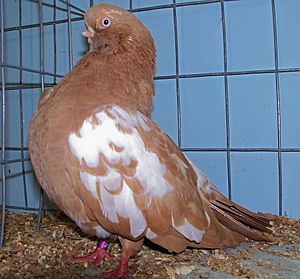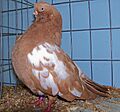English Short-faced Tumbler facts for kids

English Short-faced Tumbler
|
|
| Conservation status | Common |
|---|---|
| Other names | English Short-face Tumbler |
| Classification | |
| US Breed Group | Tumblers, rollers and high flyers |
| EE Breed Group | Tumbler and highflyer |
| Notes | |
| "Face" in the name of this breed refers to the distance from the centre of the eye to the corner of the mouth. Compare with the English Long-faced Tumbler. | |
|
|
The English Short-faced Tumbler is a unique type of pigeon that has been carefully developed over many years. It's known as a "fancy pigeon" because people have selectively bred it for its special looks and features.
This breed, like all other kinds of domestic pigeons, originally came from the wild Rock dove (Columba livia). The English Short-faced Tumbler is a very old breed. It was even mentioned in a book from 1735 by John Moore, which described different pigeon types known in England at that time.
| Top - 0-9 A B C D E F G H I J K L M N O P Q R S T U V W X Y Z |
What is a Fancy Pigeon?
A fancy pigeon is a type of domestic pigeon that has been bred by humans for specific traits. These traits can include their appearance, such as feather patterns or colors. They can also be bred for their flying style or other unique behaviors.
People who breed fancy pigeons are often called "fanciers." They work hard to create pigeons that meet certain standards. This is a bit like how different dog breeds have unique looks and personalities.
Selective Breeding Explained
The process of creating fancy pigeons is called selective breeding. This means that breeders choose pigeons with the best or most interesting features. They then breed these pigeons together. Over many generations, the desired traits become stronger and more common in the offspring.
For example, if a breeder wants a pigeon with a very short face, they would only breed pigeons that already have shorter faces. This careful selection helps to create new breeds or improve existing ones.
The English Short-faced Tumbler's Unique Look
The English Short-faced Tumbler gets its name from its distinctive face. The "short-faced" part refers to the short distance between the pigeon's eye and the corner of its mouth. This gives the pigeon a very compact and rounded head shape.
This breed is known for its small, neat body and often has a proud posture. They come in many different colors and patterns. Each color variation is carefully bred to maintain its specific look.
Why "Tumbler"?
The word "Tumbler" in the name refers to a special flying behavior. Some pigeons in the Tumbler group perform aerial acrobatics. They might tumble or roll backwards in the air while flying.
While not all English Short-faced Tumblers perform these tumbles, they belong to a group of pigeons known for this unique skill. This behavior is a natural part of their heritage.
History of the Breed
The English Short-faced Tumbler has a long and interesting history. It is one of the oldest known pigeon breeds. Its mention in John Moore's 1735 book, Columbarium, shows just how long people have been fascinated by these birds.
This book was one of the first to describe different pigeon breeds in England. It also gave advice on how to care for them. This means the English Short-faced Tumbler has been a popular and recognized breed for nearly 300 years.
Origin from the Rock Dove
All domestic pigeons, including the English Short-faced Tumbler, are descendants of the wild Rock dove. Rock doves are found all over the world, often living on cliffs or in cities. They are known for their grey feathers and iridescent neck.
Over thousands of years, humans started to tame and breed these wild pigeons. This led to the incredible variety of domestic pigeons we see today. Each breed, like the English Short-faced Tumbler, carries the genes of its wild ancestor.
Caring for English Short-faced Tumblers
Like all pigeons, English Short-faced Tumblers need proper care. They require a clean and safe home, often called a loft or dovecote. This protects them from predators and bad weather.
They also need a balanced diet of seeds, grains, and fresh water. Regular health checks are important to keep them strong and healthy. Many fanciers enjoy spending time with their pigeons, watching them fly and interact.
Images for kids


